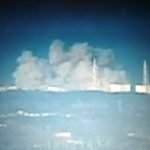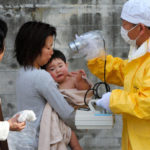
Originally Published in: Green Patriot Eco Blog
March 12, 2011
On January 12, 1965, at 10:58 a.m., a rocket was launched at the Nevada nuclear test site from a launch pad called Jackass Flats. It was an appropriate name for the site of one of the world’s first launchings of a nuclear-powered rocket that would be purposefully exploded during midflight. Soon thereafter, in what has been described as an “intentional accident,” the rocket’s nuclear core burned off. In the sky, as the core burned brightly, some scientists likened the phenomenon to a Roman candle.
The radioactive cloud traveled with the southwesterlies, first over Death Valley, floating silently over Los Angeles—then a metropolitan region of six million—drifting unseen by Los Angeles’s residents, seen only by a pilot in a lone reconaissance aircraft tracking the cloud to see which direction it would travel. The cloud drifted over the Pacific, and then the pilot turned around and returned to his base.
The nuclear fission materials rained down on the fields where dairy cows and cattle grazed and on the reservoirs holding water transported via the California aqueduct from the northern, water-rich portion of the state that quenched the thirst of the millions of residents of metropolitan Los Angeles. The nuclear rain fell, drifting, falling silently on the largest boom town west of the Rockies. The secret remained hidden from residents nearly thirty years.
Yet, within hours, fresh milk from dairies was rushed to stores and doorsteps of homes throughout the metropolitan region. Because it was fresh, the milk contained both short- and long-lived radioactive contaminants. The beta-emitting particles from isotopes of strontium 90, iodine 131, and other radioactive substances contaminated the tissues of women, lodging in bones, energetically emanating outward, damaging cells and women’s immune systems.
It was the Cold War, allegedly, that justified the experimental nuclear explosion that nearly thirty years turned six million people in the land of movie sets and beaches into, what a 1994 Los Angeles Times report termed, “human guinea pigs.”
The exposure was alleged to be so small it was of little or no significance. The Department of Energy (DOE) reported in 1994 that, some fifteen miles from the test site, the maximum whole-body radiation exposure was measured at six millirads—allegedly equal to the amount of radiation a woman would receive on a round-trip cross-country airline flight. In fact, however, these measurements were only for gamma radiation. Nobody measured beta radiation from the strontium 90 and other isotopes that would lodge in the bones of men and women for their lifetimes, continually emitting radiation into their bodies’ cells.
Moreover, the nuclear rain, of which this intentional accident was symbolic, in fact had begun much earlier to pour down on the belly of the nation. In the early morning hours of January 27, 1951, when it was still dark, a single Air Force B-50 bomber dropped an atomic bomb on the Nevada desert. The flashing radiance, heralding the beginning of above-ground nuclear testing in America, startled ranchers in Utah and shattered glass windows onto the floors of homes in Arizona. For the next twelve years, more than one-hundred-twenty-six atomic bombs were detonated at the Nevada Test Site and a hard rain—a toxic nuclear drizzle—fell upon the vast belly of the nation.
“The radiation swept across America, contaminating the soils of Iowa and Indiana, the coastal bays of New England, and the snows of northern New York . . . Each of the pink clouds that drifted across the flat mesas and forbidden valleys of the atomic proving grounds contained levels of radiation comparable to the amount released after the explosion in 1986 of the Soviet nuclear reactor at Chernobyl.”[i]
In addition to these above-ground explosions, the DOE revealed in December, 1993 that the United States conducted some two-hundred-four secret underground nuclear tests over forty-five years, and that thirty-four of them released radiation into the atmosphere.[ii] Previous independent experts in the past grossly underestimated the number of secret underground nuclear tests, calculating that only about one-hundred-eighteen took place.[iii] In total, some one-thousand-fifty-one nuclear tests are known to have been conducted since the Nuclear Age began. Nuclear releases, secretly allowed since the 1940s and not revealed for decades, occurred, sometimes on levels as massive as Chernobyl.
Among the revelations:
§ In 1986 the government revealed intentional releases of radioactive iodine from the Hanford nuclear weapons plant in Washington State during the 1940s were of a magnitude that “today would be considered a major nuclear accident.”[iv] Between 1944 and 1947 alone, some two-hundred-seventy-thousand people were exposed to six-hundred-eighty-five curies of iodine-131. (By contrast, Three Mile Island, long considered a major nuclear accident, released some fourteen curries.) It is estimated that some fourteen-hundred infants and young children received radiation dosages ranging from fifteen to six-hundred-fifty rads. It is estimated that each rad of exposure results in an increase of risk for breast cancer of about one percent. Much of this probably resulted from consumption of contaminated milk.
§ The amount of radiation released from Oak Ridge, in Tennesse, during the 1940s and 1950s “could match the numbers of Hanford.”[v]
§ Diet, especially consumption of dairy foods, is the major route of exposure to radioactive fallout and nuclear releases. Milk from dairies, located nearby reactors, reaches consumers within days of the deposition of short-lived radioactive contaminants, such as iodine and strontium. In the Hanford nuclear weapons plant study, begun in 1988, “preliminary findings point to the milk of cows that ate iodine-laced vegetation as the most likely source of humans.”[vi]
§ Nonmilitary use of nuclear power also has resulted in massive environmental contamination. The first one-hundred largescale nuclear reactors built prior to 1972 were intentionally designed to allow large quantities of radioactivity into the air. Between 1970 and 1979 as the new one-thousand megawatt civilian nuclear power plants began to operate, engineering flaws resulted in dramatically increased releases of radioactive contaminants into the environment.[vii]
There is little data on cancer risk from low level radiation. Past studies involving very low exposures, such as occur from trace amounts in the diet released by nuclear facilities, have suffered from the serious limitation that there was no way to establish the form of the dose-response relation, or that the populations studied around each facility were so small that it was difficult to achieve a high degree of statistical certainity. Moreover, it is not proven whether chronic, but very low level, exposures to ingested nuclear fission products are as, less, or more dangerous than brief high exposures to external forms of radiation. Quite apart from increased incidence of breast cancer among atomic blast victims of Hiroshima and Nagasaki,[viii], [ix], [x], [xi]the most relevant, well-documented studies are those among women in the United Kingdom who were employed in the manufacture of glow-in-the-dark watches. These women, applying radium to watch faces, got bits of radium on their fingers and lips. They were literally ingesting small amounts. They suffered excess rates of breast cancer deaths.[xii] According to EPA data, about 49 million people drink water containing significant levels of radioactive radon, and millions more drink water contaminated with radium, uranium, and other radioactive substances.[xiii] In a 1994 report, cancer incidence in the Dalgety Bay area of Fife, Scotland, was examined following the detection of radium-226 particles by routine radiation monitoring. Among cancers that were reported to be elevated were those of the breast.[xiv]
Another study that suggests there is a breast cancer risk to nuclear fission products is based on cancer statistics in the counties of Suffolk and Nassau in Long Island, and Westchester north of New York City. According to this study, breast cancer mortality increased sharply around two large nuclear reactors in southeastern Connecticut in direct relation to the measured pattern of accumulated strontium-90 in the local milk.[xv], [xvi]
The Millstone plant in Waterford, Connecticut, is located only about ten miles from Suffolk County. Between 1970 and 1987, Millstone Unit 1 in Waterford reported the “highest emissions of airborne and liquid fission products ever released from any nuclear reactor in the United States . . .”[xvii] Due to these massive releases, levels of strontium-90 in milk at the closest sampling station five miles northwest of the Millstone plant reached a concentration in 1976 that was higher than even the amounts recorded in 1961-1962 during the height of nuclear weapons testing.
There can be no doubt that these enormous releases reached nearby Suffolk and Nassau counties in Long Island, as well as Westchester north of New York City. “An examination of the radiation doses received by the population drinking the milk in Waterford and nearby New London . . . indicates that the accumulated doses to the bones of children over the period 1970-1975 reached values of about 640 millirads from the milk and other food produced in the area, and about 320 millirads to the bone-marrow. This must be compared with a dose of some 2 millirads to the bone-marrow from a typical chest x-ray, so that the very radiation sensitive bone-marrow of children in the New London area received the equivalent of some 160 chest x-rays in the course of 6 years of their most sensitive period of growth and development.”[xviii], [xix]
Although between 1944 and 1970, breast cancer incidence began to rise at a constant rate in Connecticut, the rate of rise increased sharply following operation of the Millstone plant in 1970 and the Haddam Neck plant, near Middletown, Connecticut, in 1967. The first peak occurred in 1974-1975, some seven to nine years after the first releases from Haddam Neck in 1967, while a second broader rise occurred in 1983-1985, some seven to nine years after the largest releases from the Millstone Unit 1 reactor in 1974-1976.[xx]
There are far more unanswered, than answered, questions surrounding risks posed by nuclear fission products. It has been postulated by some that low, cumulative doses of radiation from dietary exposures are one-hundred to one-thousand times more dangerous than brief, high exposures as in the case of atomic bomb blasts or x-rays. It is known, in fact, that exposure to nuclear fission products impair the body’s defenses against cancer by depleting it of protective enzymes such as superoxide dismutase.[xxi] Moreover, it is thought that our bodily tissues are irradiated by the intense and highly energetic beta particles stored in the bones. This combination of immune damage and simultaneous carcinogenic exposure may explain why breast cancer mortality rates began to increase in areas of low level exposures, such as Nassau, Suffolk, and Westchester counties, within only a few years after fresh fission products enter the diet.[xxii] Moreover, although it is known that external radiation synergizes hormones,[xxiii], [xxiv] it is not known whether nuclear fission contaminants in the diet do the same.
In spite of these uncertainities, such exposures are clearly a risk factor for other cancers. For example, some two-thirds of over forty studies in the literature reviewed by Shleien and co-workers in Health Physics in 1991 showed an increase in cancer rates in populations around nuclear facilities.[xxv] Thus, it is only prudent for women to take measures to protect themselves. As John Bailar III, M.D., Ph.D., chair of the Department of Epidemiology and Biostatistics at McGill University, notes in speaking of radiation, “We’re not doing enough to limit exposure . . . I think we have to continue to identify the sources of radiation that affect all people, because radiation comes closer to being a general carcinogen than any of the chemicals I know about.”[xxvi]
On the correlation between low dose radiation and weakened immunity, radiation physicist, Dr. Ernest Sternglass, states in a July 1986 article in the International Journal of Biosocial Research: “It appears that perhaps the most serious unanticipated effects of fallout is long-term, persistent immune deficiency . . . It can weaken the immune defenses of the body at very low total doses leading to unexpectedly large increases in infectious diseases and cancers.”
Initially zealous misrepresentation of the facts led the public to understand that small amounts of radiation were of no special concern. Yet these low levels are exactly the cause of weak immunity and resulting diseases. Authorities couldn’t ignore emerging data and in December 1989, the government-sponsored National Academy of Sciences stated in a report titled Biological Effects of Radiation that there was no safe level of radiation.
Low protracted doses of radiation cause physiological damage through the formation of free radicals that damage human immune function. A free radical is a molecule with an imbalance in electrons which can destabilize other molecules resulting in cellular damage and disease.
In high, short doses like the Hiroshima bomb blast, radiation primarily causes direct damage to the nucleus of cells where the genes are located that control the functioning of the cell. In contrast, low doses acting continuously over time produce their damage indirectly through the generation of free radicals that destroy cell-membranes, hundreds to thousands of times more efficiently than might be expected in calculations related to high-dose damage. So the everyday amount of radiation that is released as part of the normal operation of the world’s 400 nuclear power plants is a very grave concern. Nuclear power plants must have releases in order to function, and these releases, even though they may be partially filtered, allow radiation to go into our air and drinking water, and onto farmland and into our food.
The everyday releases of low-level radioactivity by nuclear power plants has been found to cause several kinds of health damage including premature births, congenital defects, infant mortality, mental retardation, heart ailments, arthritis, diabetes, allergies, asthma, cancer, genetic damage and chronic fatigue syndrome. It has been linked to previously unknown infectious diseases, and the resurgence of old ones by damaging the developing white blood cells originating in the bone marrow and thus weakening the immune system.
In an interview in the October 16, 1997 National Catholic Reporter, Dr. Sternglass conjectures what could happen: “With countless thousands of persons having a weaker and weaker immune system as the result of increasing radioactive contamination of the air and food chain, an AIDS mutation-like disease could become a new Black Plague. It’s not conceivable that entire nations could be decimated.”
Follow WilderUtopia on Facebook…








Great post 🙂-


Get Your Own Pink Ribbon
April 29, 2011 at 1:27 pm
·
Pingback: fission health effects | Max Health
I?m a 3 12 months surviver. I had stage 3 and stage 4 breast cancer at the identical time, and indeed an individual morning I woke up with no hair at all, it was in the spring of 2009. I just realized my everyday life was about. But appear at me now three decades and counting. praise the lord for seeing me by means of all this. If I can make it you can too. Have faith in the lord and he understands whats finest. and most of all many thanks to my household and close friends, I hung on for the full journey. For the duration of my solutions my little ones stood by me , and during this time I lost my oldest son Nathaniel in an automobile accident. Befor he died he manufactured me guarantee not to give up the fight. and I appreciate him for that.
An Array of Utopian Flowers
Dark Ecosystems: Art and the Journey Beyond Borders at Bienal SACO
Saving Grizzlies: The Fight Against Extinction and Habitat Loss
Psychedelic Frontiers: Paul Stamets on the Healing Power of Mushrooms
Emulating Nature’s Wisdom: The Biomimicry Blueprint
Tales of the Fifth Dimension – The Fifth Fedora
Transformative tales that thrive in the world of Lost Souls, Fallen Angels, Shapeshifters, Extra-Planetary Dragons, and Lucky Charms. From an assortment of writers, now available from Borda Books and WilderUtopia Books is The Fifth Fedora: An Anthology of Weird Noir & Stranger Tales curated by Jack Eidt and Silver Webb.
Buy the book!
‘Medicine Walk’ Featured in SBLitJo
Santa Barbara Literary Journal
‘Bellatrix: Volume 3’, features adventurous fiction, poetry, essays, and lyrics, and an excerpt of Jack Eidt’s psychic-animism fiction, Medicine Walk.
Buy the book!Wildly Popular